

Creating Students That Solve Problems. Creating Students That Solve Problems by Paul Moss Ed note: This is part 1 in a 2-part series on teaching students to think for themselves.

Tomorrow, we’ll provide 12 strategies to address the ideas below. The next time you are in a lesson, ask yourself how many questions you are asked that don’t really need to be asked. If the answer is too many, you are not alone. Www.australiancurriculum.edu.au/GeneralCapabilities/Pdf/Critical-and-creative-thinking. Critical Thinking Model 1. To Analyze Thinking We Must Identify and Question its Elemental Structures Standard: Clarityunderstandable, the meaning can be grasped Could you elaborate further?
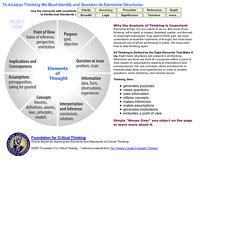
'Critical-Thinking' in 21st Century Learning and Teaching. New Evidence: Deeper Learning Improves Student Outcomes. When educators learn about the work of Envision Schools and the work of our partner schools in the Deeper Learning Network, they almost always ask for evidence or data to show that this approach is better than traditional approaches to learning.
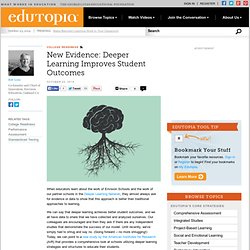
We can say that deeper learning achieves better student outcomes, and we all have data to share that we have collected and analyzed ourselves. Our colleagues are encouraged and then they ask if there are any independent studies that demonstrate the success of our model. Until recently, we've simply had to shrug and say no. Critical Thinking. Resources and Downloads for Teaching Critical Thinking. Tips for downloading: PDF files can be viewed on a wide variety of platforms -- both as a browser plug-in or a stand-alone application -- with Adobe's free Acrobat Reader program.
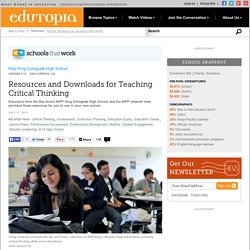
Click here to download the latest version of Adobe Reader. Click on any title link below to view or download that file. Resources On This Page: Lesson Plans & Rubrics KIPP King Curriculum Planning Guide <img height="12" width="11" class="media-image media-element file-content-image" src="/sites/default/files/styles/content_image_breakpoints_theme_edutopia_desktop_1x/public/content/08/pdficon.gif? Report Finds ‘Deeper Learning’ Model Improves Outcomes for All Students. The conversation about what kids need to know and to be able to do by the end of high school has gradually shifted over the past several years to emphasize not just rigorous content goals, but also less tangible skills, such as creative thinking, problem-solving and collaboration.

That shift has brought schools that are practicing “deeper learning” into focus. The William and Flora Hewlett Foundation has been a big supporter of this work, defining deeper learning as a model that focuses on critical thinking, communication, collaboration, academic mindsets and learning how to learn, all through rigorous content. New research conducted by the American Institutes for Research (AIR) has found that the deeper learning model does have positive learning outcomes for students, regardless of their background.
The model is often critiqued as a framework that only works for high-achieving learners. AIR investigators also looked at more traditional measures of achievement — tests. The 5 Step Model to Teach Students Critical Thinking Skills. 7 Tenets of Creative Thinking. In school, we learn about geniuses and their ideas, but how did they get those ideas?
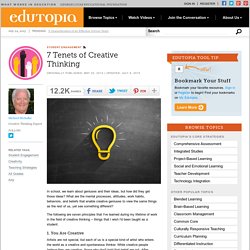
What are the mental processes, attitudes, work habits, behaviors, and beliefs that enable creative geniuses to view the same things as the rest of us, yet see something different? The following are seven principles that I've learned during my lifetime of work in the field of creative thinking -- things that I wish I'd been taught as a student. 1. You Are Creative Artists are not special, but each of us is a special kind of artist who enters the world as a creative and spontaneous thinker. 2. You must show passion and the determination to immerse yourself in the process of developing new and different ideas. 3.
When producing ideas, you replenish neurotransmitters linked to genes that are being turned on and off in response to challenges. 4. Your brain is a dynamic system that evolves patterns of activity, rather than simply processing them like a computer. 5. 6. Resources and Downloads for Teaching Critical Thinking. 6 Steps to Help Students Find Order in Their Thinking. Like magic, the fish turn into birds and then back into fish.
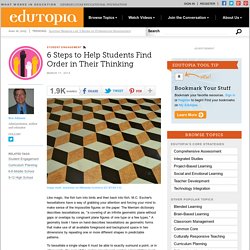
M.C. Escher's tessellations have a way of grabbing your attention and forcing your mind to make sense of the impossible figures on the paper. The Merriam dictionary describes tessellations as, "a covering of an infinite geometric plane without gaps or overlaps by congruent plane figures of one type or a few types. " A geometry book I have on hand describes tessellations as geometric forms that make use of all available foreground and background space in two dimensions by repeating one or more different shapes in predictable patterns. To tessellate a single shape it must be able to exactly surround a point, or in other words, the sum of the angles around each point in a tessellation must be 360.
Critical Thinking. The Importance Of Critical Thinking. Source: www.eftbrisbane.com | Original Post Date: January 3, 2009 - Critical thinking is an incredibly important skill.
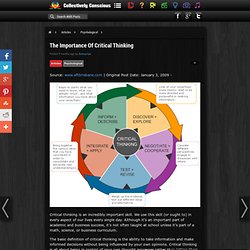
We use this skill (or ought to) in every aspect of our lives every single day. Although it’s an important part of academic and business success, it’s not often taught at school unless it’s part of a math, science, or business curriculum. Teaching Critical Thinking in Age of Digital Credulity. Critical Thinking Pathways. Critical thinking is trendy these days.

With 6.3 million hits resulting from a Google search -- six times "Bloom's Taxonomy" -- its importance is undeniable. Worldwide, critical thinking (CT) is integrated into finger-painting lessons, units on Swiss immigrants, discussions of Cinderella, and the Common Core State Standards. In short, critical thinking is more beloved than Egyptian cotton. Definitions abound. Using Webb's Depth of Knowledge to Increase Rigor. The word "rigor" is hard to avoid today, and it provokes strong reactions from educators.
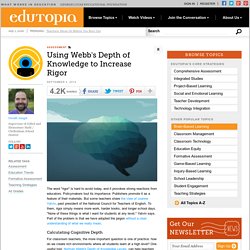
Policymakers tout its importance. Publishers promote it as a feature of their materials. But some teachers share the view of Joanne Yatvin, past president of the National Council for Teachers of English. To them, rigor simply means more work, harder books, and longer school days. The Secret Skill Behind Being An Innovator. Overloaded with information, students need critical thinking skills. Students today have unprecedented access to information. According to educator Karl Fisch, in one week of reading The New York Times, an individual will encounter more information than people in the 18th century would have had access to during the entire course of their lives. Defining Critical Thinking. Developing critical thinking. It means not taking what you hear or read at face value, but using your critical faculties to weigh up the evidence, and considering the implications and conclusions of what the writer is saying.
Imagine two situations. On the first, you are on a country walk and you come across a notice which tells you not to attempt to climb a fence because of risk of electrocution. Would you pause to consider before obeying this instruction? On the other hand, suppose you were to receive a letter from a local farmer announcing that he proposed to put up an electric fence to protect a certain field. In this case, would you not be more likely to think about his reasons for doing so and what the implications would be for you and your family? An allied skill is the ability to analyse – that is, to read or listen for the following points: How robust are the points presented as evidence? Why It's Time To Start Teaching Students How To Think - Edudemic - Edudemic#%21#%21#%21.
As an elementary teacher, I can’t help but notice that children today want quick answers and do not take the time to think things through. This is probably the result of living in today’s age of technological instant gratification. Criticalthinkingreviewfinal.